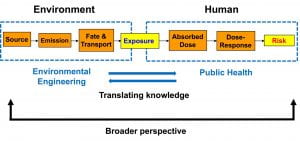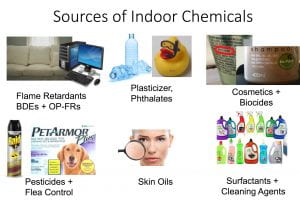The overall goal of my research is to advance our knowledge of the complex etiology of adverse health outcomes in humans due to environmental chemical exposures from the use of common household products or environmental emissions within the context of environmental risk assessment. My primary research expertise is assessing human exposure to environmental chemicals for use in risk assessment and epidemiological studies.
When conducting research, I primarily use three data science skills:
- Statistics to infer something about the relationships within the data or statistical models to create a model that is able to predict future values
- Mathematical models to better understand and predict the fate and transport of environmental pollutants in various environmental systems
- Machine learning to make the most accurate predictions possible when the underlying mechanisms are not of interest or cannot be easily revealed

My current research interests include:
- Environmental risk factors of autism spectrum disorder
- Mathematical modeling of environmental quality
- Exposure to consumer product chemicals
- High-throughput chemical screening and prioritization
Environmental risk factors of autism spectrum disorder
Compared to etiologic research on genetics, little is known about non-genetic causes of autism spectrum disorder (ASD). Thus, I am interested in developing novel approaches to advance our knowledge of the complex etiology of autism due to chemical exposures through epidemiologic studies. As a principal investigator, I recently completed two NIEHS-funded projects (R21-ES025551, R21-ES028131) to examine whether exposures to phthalates or per- and polyfluoroalkyl substances (PFAS) are associated with an increased risk of ASD. These projects investigate the role of environmental chemical exposures from the use of common household products to address the critical question: “Are common household exposures associated with risk for ASD?” I also recently started a NIEHS-funded project (R21-ES033389) to examine whether prenatal exposure to NIS (sodium/iodide symporter) inhibitors and/or iodine deficiency is associated with increased risk of thyroid dysfunction, resulting in increased risk of child ASD.
We collaborate with researchers at the University of California Davis and leverage existing resources available in two large epidemiology projects: “CHARGE” (CHildhood Autism Risk from Genetics and Environment) and “MARBLES” (Markers of Autism Risk in Babies – Learning Early Signs).

Mathematical modeling of environmental quality
Health issues related to environmental chemical releases have increasingly attracted public attention over the last few decades. For this reason, one of my research interests is to address environmental health issues by better understanding the fate and transport of environmental pollutants. For example, in order to address the health risk of perfluorooctanoic acid (PFOA) released from one of the major chemical facilities in the United States, I integrated multiple single medium models and thus was able to predict concentrations of PFOA in air, soil, and groundwater. This comprehensive modeling formed the basis for various epidemiological studies of PFOA in the C8 Health Project to connect PFOA exposures to potential adverse health effects.

(Photo courtesy of the U.S. Geological Survey)
Exposure to consumer product chemicals
Because of increasing health concerns associated with chemical exposures from household products and building materials, indoor environments have been recognized as an important research area for understanding the impact of chemical exposures on human health. As a co-investigator of the project funded by the U.S. Environmental Protection Agency (EPA, PI: Deborah Bennett, UC Davis), I conducted various modeling studies with goals (1) to understand the source strength, fate, and transport of semivolatile organic compounds in a residential indoor environment and (2) to better estimate human exposure to a large number of chemicals from the widespread use of common household products and building materials. I plan to expand this area with additional efforts on identifying hazardous compounds, which will eventually improve human health via source reduction. Funded by Syngenta, I am currently leading an exposure modeling project to provide realistic distributions of pesticide exposure in an indoor residential setting. The overall outcome of this project will be improved understanding of residential exposure to pesticides.

High-throughput chemical screening and prioritization
While a growing number of chemicals have been developed and introduced into commerce over the past several decades, there is a dearth of exposure and toxicity information available to assess potential harmful effects of these chemicals to humans or to provide information needed to regulate and screen chemicals. For this reason, I am interested in high-throughput screening assessments that incorporate both exposure and toxicity data for risk-based screening and prioritization.
